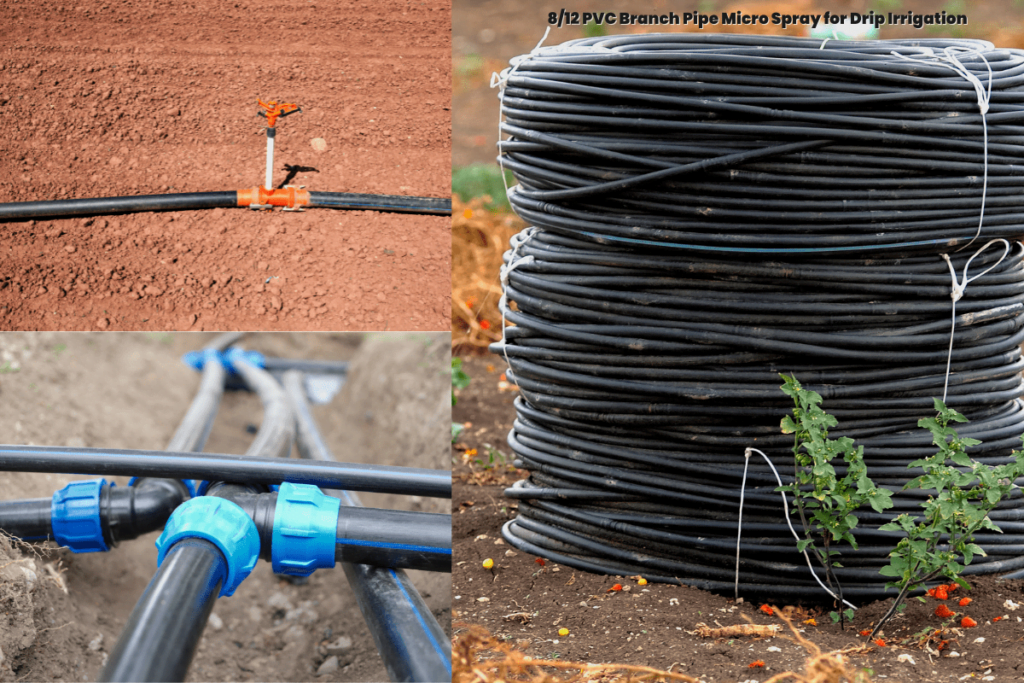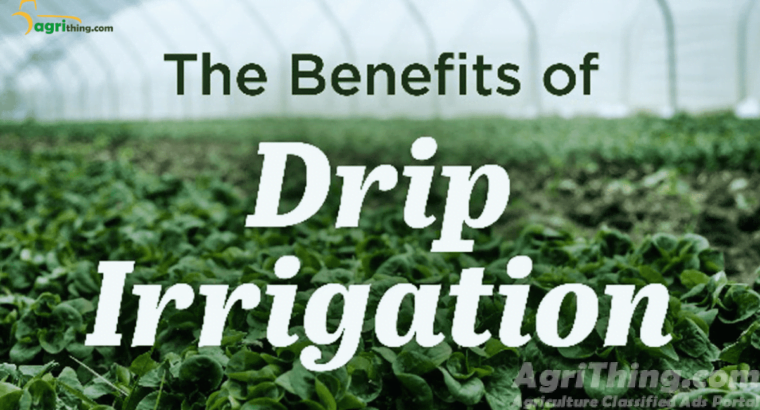Experience the benefits of Drip Irrigation for Healthy Plants
Drip irrigation delivers water directly to the root zone of plants using a system of tubes or pipes with small emitters or drippers. The benefits of drip irrigation system contribute to efficient water usage, improved plant health, and reduced weed growth.
The benefits of drip irrigation make it widely used in gardens, landscapes, and agricultural settings, enabling water conservation and enhancing plant health. Drip irrigation is known for its efficiency because it provides plants with a consistent and controlled water supply. In this article, we will discuss the benefits of drip irrigation system.
Table of Contents
Benefits of drip irrigation system
Drip irrigation offers several benefits for efficient water usage, improved plant health, and reduced weed growth. These benefits make it a sustainable and environmentally friendly choice for irrigation in various settings. Here are the key advantages of drip irrigation:
| Water conservation Water conservation is highlighted firstly in the benefits of the drip irrigation system. Its highly efficient watering method delivers water directly to the plant’s root zone and minimizes water wastage. This targeted approach ensures that water is used more effectively, resulting in significant water savings compared to other irrigation methods. |
| Enhanced plant health Enhancing plant health is also included in the benefits of drip irrigation systems. It provides plants with a consistent and controlled water supply. It promotes healthier growth and development by delivering water directly to the plant’s root zone. Therefore, drip irrigation ensures that plants receive sufficient water without excessive moisture. |
| Reduced weed growth Drip irrigation systems deliver water only to the desired plant’s root zone, minimizing water availability to weeds. Since water is not sprayed over a large area, the soil surface between plants remains relatively dry, discouraging weed germination and growth. Additionally, drip irrigation reduces weed competition by providing water directly to the desired plants, enabling them to outcompete weeds for resources. |
| Improved fertilizer efficiency Drip irrigation allows for the precise application of fertilizers directly to the plant’s root zone. By supplying nutrients directly to the roots, fertilizers are more efficiently absorbed. Therefore minimizing nutrient leaching and wastage. As a result, the overall amount of needed fertilizers decreased. |
| Customizable and scalable Drip irrigation systems are highly versatile and can be tailored to meet specific needs. They can be designed to accommodate various soil types, plant types, and terrain. Drip systems are easily expandable, allowing new plants or areas to be added without significant modifications. |


| Soil erosion prevention Drip irrigation applies water directly to plants’ root zone, minimizing water’s impact on the soil surface. Drip irrigation helps prevent soil erosion, especially on sloped terrain, by reducing the force of water hitting the ground. This is particularly beneficial in areas prone to erosion or where soil conservation is a concern. |
| Energy efficiency Drip irrigation systems operate at a lower pressure than traditional sprinkler systems, reducing energy requirements for pumping water. The lower pressure requirements translate into energy savings, making drip irrigation an energy-efficient choice for irrigation, primarily when powered by renewable energy sources. |
| Weed control Drip irrigation reduces water availability to weed seeds and seedlings by delivering water only to the desired plants. This targeted watering method helps suppress weed growth and minimizes the need for manual weeding or herbicide application. As a result, drip irrigation can contribute to a more weed-free and visually appealing landscape. |
| Disease prevention Disease prevention is also included in the benefits of drip irrigation. It keeps plant foliage dry by delivering water directly to the root zone. This moisture control helps reduce the likelihood of fungal diseases that thrive in damp conditions. Drip irrigation can help prevent diseases such as powdery mildew and leaf spot by minimizing leaf wetness, leading to healthier plants and reduced reliance on fungicides. |
| Versatility with water sources These systems can be designed to accommodate various water sources. These sources include recycled or treated water. By utilizing alternative water sources, drip irrigation helps conserve freshwater resources, reducing the strain on traditional water supplies. |
| Reduced labor and maintenance Once installed, drip irrigation systems require minimal maintenance compared to other irrigation methods. The absence of sprinklers or overhead watering reduces the need for adjusting and cleaning sprinkler heads. Additionally, the precise water application of drip irrigation reduces watering frequency. It allows for automated scheduling, reducing labor and time spent on manual irrigation. |
| Improved crop yield and quality The consistent and precise water supply provided by drip irrigation can improve crop yields and higher-quality produce. Drip irrigation promotes optimal growth conditions by ensuring that plants receive water and nutrients when needed, leading to healthier and more productive crops. Unlock the Profitability Potential in Agriculture with the Precious Benefits of Drip Irrigation. |
Conclusion
In summary, the advantages and benefits of drip irrigation system are wide range over traditional watering methods. Firstly, it conserves water by delivering it directly to the root zone, minimizing evaporation and runoff. These advantages make drip irrigation desirable for various applications, from minor to large-scale agricultural operations. It contributes to sustainable water management and efficient plant growth.
Additionally, drip irrigation promotes healthier plants by providing a consistent water supply, reducing the risk of overwatering or underwatering. Furthermore, the benefits of drip irrigation encompass the controlled water application, preventing weed growth as the foliage remains dry.
Frequently Asked Question (FAQ’s)
What are the benefits of drip irrigation?
The benefits of a drip irrigation system include water conservation, enhanced plant health, reduced weed growth, improved fertilizer efficiency, and customizable scalability. An efficient and sustainable irrigation method promotes resource conservation and optimal plant growth.
How do I install a drip irrigation system?
Installing a drip irrigation system involves laying out the tubing or pipes along the planting area, connecting them to a water source, and placing emitters near the plants. Following manufacturer instructions or consulting a professional for proper installation is recommended.
How much water does drip irrigation save compared to other methods?
Drip irrigation is known for its water-saving capabilities. On average, drip irrigation can save 30-50% more water than traditional sprinkler systems, as it delivers water directly to plant roots with minimal evaporation and runoff.
Can I automate my drip irrigation system?
Yes, drip irrigation systems can be automated using timers or controllers. These devices allow you to set specific watering schedules, ensuring that your plants receive water consistently and efficiently, even when you cannot manually operate the system.
How do I maintain a drip irrigation system?
Routine maintenance for a drip irrigation system includes checking for clogged emitters, repairing or replacing damaged tubing, and adjusting the system as plants grow. Flushing the system periodically can help prevent clogs and ensure optimal performance.
Get your 8/12 PVC Branch Pipe Micro Spray for Drip Irrigation, Garden Irrigation, and more at Agricomplex. Don’t wait, shop now!

Related Articles
Want to learn more about Benefits of Drip irrigation? Visit our website. Easy and helpful information just for you!
People Also Asked
Can a drip irrigation system help reduce weed growth?
Yes, drip irrigation systems can contribute to weed control. By delivering water directly to the plant roots, the surrounding soil remains relatively dry, making it less favorable for weed germination and growth. Additionally, targeted water delivery prevents weed seeds from being dispersed by sprinkler systems or overhead watering.
Do drip irrigation systems save time and labor compared to other methods?
Yes, drip irrigation systems can save both time and labor. Once properly installed and set up, they require minimal maintenance and allow for automated watering schedules. This eliminates manual watering and reduces the time and effort spent on irrigation tasks, freeing up resources for other essential gardening activities.
Are there any additional benefits of drip irrigation systems?
In addition to water conservation, improved plant health, and reduced weed growth, drip irrigation systems offer several other advantages. These include reduced soil erosion, prevention of leaf diseases caused by excessive moisture, and the ability to apply fertilizers and nutrients directly to the plant roots, enhancing their absorption and effectiveness. The benefits of drip irrigation extend beyond water efficiency and contribute to overall crop productivity and sustainability.
Does a drip irrigation system promote environmental sustainability?
Absolutely! Drip irrigation systems align with environmental sustainability goals in multiple ways. Conserving water, they help protect this valuable resource, especially in regions prone to drought or water scarcity. Additionally, the benefits of drip irrigation extend to a healthier environment as it reduces the reliance on chemical fertilizers and pesticides that can potentially leach into groundwater.
Can a drip irrigation system be integrated with smart technology?
Drip irrigation systems can be integrated with smart technology and automated systems. This allows precise control over watering schedules, duration, and flow rates. Using sensors, timers, and controllers, you can optimize irrigation efficiency, respond to weather conditions, and even remotely control the system using smartphone apps or computer interfaces.

